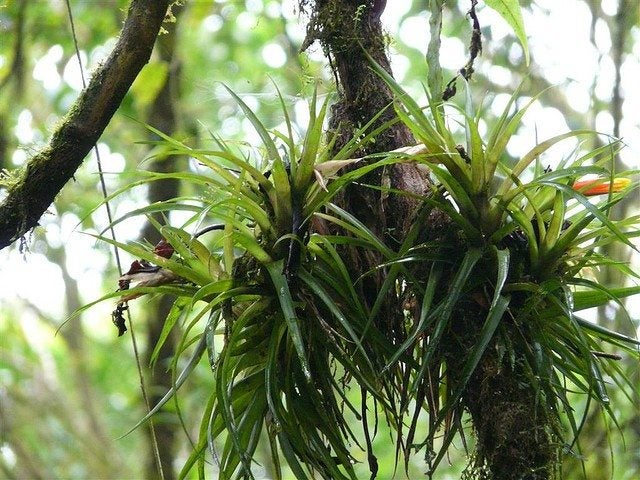Types Of Epiphytes - What Is An Epiphyte Plant And Adaptations Of Epiphytes


Both tropical and rainforests feature an incredible array of plants. Those that dangle from trees, rocks, and vertical supports are called epiphytes. Tree epiphytes are called air plants because they have no firm grip in the earth. This fascinating collection of plants is also fun to grow indoors or out in the garden. Find answers on what is an epiphyte plant so you can introduce this unique form to your indoor or outdoor landscape.
What is an Epiphyte Plant?
The word epiphyte comes from the Greek “epi,” which means “upon” and “phyton,” which means plant. One of the amazing adaptations of epiphytes is their ability to attach to vertical surfaces and capture their water and much of their nutrient needs from sources other than soil. They may be found on branches, trunks, and other structures. While epiphytes may live on other plants, they are not parasites. There are many types of epiphytes, with the majority being found in tropical and cloud forests. They get their moisture from the air but some even live in desert terrain and gather moisture from fog.
Types of Epiphytes
You might be surprised what plants have the adaptations of epiphytes. Tree epiphytes are usually tropical plants such as bromeliads, but they may also be cacti, orchids, aroids, lichens, moss, and ferns. In tropical rain forests, giant philodendrons wrap themselves around trees but are still not tethered to the ground. The adaptations of epiphytes allow them to grow and flourish in areas where ground is difficult to reach or already populated by other plants. Epiphytic plants contribute to a rich ecosystem and provide canopy food and shelter. Not all plants in this group are tree epiphytes. Plants, such as mosses, are epiphytic and may be seen growing on rocks, the sides of houses, and other inorganic surfaces.
Adaptations of Epiphytes
The flora in a rainforest is diverse and thickly populated. The competition for light, air, water, nutrients, and space is fierce. Therefore, some plants have evolved to become epiphytes. This habit allows them to take advantage of high spaces and upper story light as well as misty, moisture-laden air. Leaf litter and other organic debris catches in tree crotches and other areas, making nutrient-rich nests for air plants.
Epiphyte Plant Care and Growth
Some plant centers sell epiphytic plants for home gardeners. They need to have a mount in some cases, such as Tillandsia. Affix the plant to a wooden board or cork piece. The plants gather much of their moisture from the air, so place them in moderate light in the bathroom where they can get water from shower steam. Another commonly grown epiphyte is the bromeliad. These plants are grown in well-drained soil. Water them in the cup at the base of the plant, which is designed to capture moisture out of misty air. For any epiphytic plant, try to mimic the conditions of its natural habitat. Orchids grow in shredded bark and need average light and moderate moisture. Take care not to overwater epiphytic plants since they supplement their moisture needs from the air. Humid conditions often provide all the moisture a plant will need. You can assist the plant by misting the air around it or putting the pot in a saucer of rocks filled with water.
Sign up for the Gardening Know How newsletter today and receive a free copy of our e-book "How to Grow Delicious Tomatoes".

Bonnie Grant is a professional landscaper with a Certification in Urban Gardening. She has been gardening and writing for 15 years. A former professional chef, she has a passion for edible landscaping.